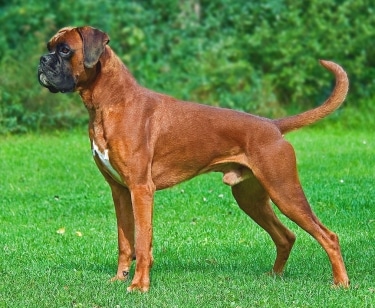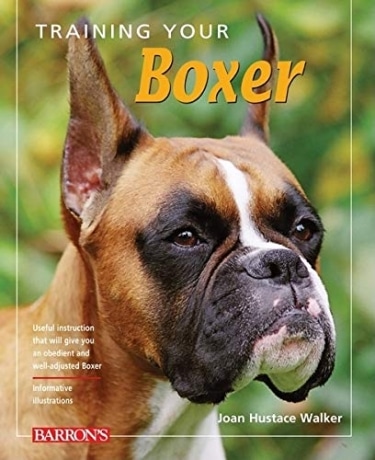
Late in the 19th Century in Germany, a mastiff-type dog known as the Brabanter Bullenbeisser was crossed with the British Bulldog, and the Boxer was created. It was primarily a security, guard, and work dog. Early breeders tried unsuccessfully to create an all-black dog and settled on the fawn and brindle colors commonly seen today.
The Boxer gained popularity in North America after World War I when returning servicemen brought back Boxers with them; by the second World War, the breed was established and well-favored as a family protector and friend. The energetic Boxer needs daily outdoor exercise.
Height: The height for a Boxer is between 21 – 25″ (53.3 – 63.5cm)
Weight: The weight for a Boxer is between 66 – 70 lbs (29.5 – 31.2 kg)
Coat Type: The Boxer’s flat, close-lying coat is short and lustrous, with acceptable colors being fawn and brindle. White markings must not exceed more than one-third of the dog. A weekly rub-down keeps the Boxer’s coat looking sleek and healthy.
Temperament: The most important characteristics of the Boxer are his alertness and self-confidence. However, he is also a playful dog, although gentle and patient with children. The Boxer is fiercely loyal, intelligent and easily disciplined; he is cautious with strangers but responds quickly to friendly invitations. These qualities make the Boxer a well-loved family guardian and pet.
Health Problems: Health concerns which may affect the Boxer include cancer, heart problems, epilepsy, hip dysplasia, hypothyroidism, degenerative myelopathy, allergies, bloat and intestinal as well as eye problems.
Special Interest:
• It is said that Boxers derived their name from the fact that they “box” with each other while at play.
Classifications:
AKC: Group 3 – Working Dogs
ANKC: Group 6 – Utility
CKC: Group 3 – Working Dogs
FCI: Group 2 Section 2 Molossoid breeds
KC: Non-Sporting – Working Group
NZKC: Utility
UKC: Guardian
Kennel.com Recommends Training Your Boxer
Training Your Boxer
 Kennel.com – Complete Guide to Dogs The Dog Lovers Guide
Kennel.com – Complete Guide to Dogs The Dog Lovers Guide